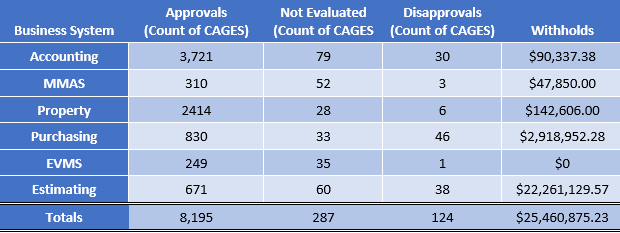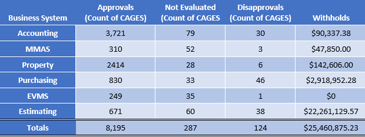You may be familiar with DCMA’s Contract Business Analysis Repository (CBAR). DCMA uses CBAR to collect contract related information about companies doing business with the DoD. It provides DoD contracting officers with information about contractors such as their indirect and direct rates, status of business systems and withholds, CAS Disclosure statements, and forward pricing rates.
The Defense Federal Acquisition Regulation Supplement (DFARS) Subpart 242.70, Contractor Business Systems, discusses penalties that can occur should a contracting officer determine a contractor’s business system is deficient. Depending on the clauses placed on contract, a contractor may be subject to withholds when there are significant business system deficiencies. Cost estimating systems are one of the six business systems subject to this business system rule.
DCMA recently released their November, 1st 2019 statistics about the six contractor’s business systems and withholds from the data they maintain in CBAR. The following table shows a summary of these statistics.
 Table showing the November 2019 DCMA CBAR Statistics of Contractor Business Systems and Withholds
Table showing the November 2019 DCMA CBAR Statistics of Contractor Business Systems and Withholds
What’s interesting about these statistics?
Perhaps like us, you also noticed the amount and high percentage of withholds for cost estimating system deficiencies – over $22M and 88% of the total amount of withholds. That’s an expensive penalty companies are paying for issues with their cost estimating systems. Hopefully, your company isn’t one of those withhold statistics.
To make sure your company doesn’t become a withhold statistic, you may want to review the DFARS Subpart 252.215-7002, Cost Estimating System Requirements clause, to ensure you have cost estimating processes and procedures in place. Section (d) describes the system requirements. Section (d) (4) includes a list of 17 functions an acceptable cost estimating system should accomplish.
Similar to other business systems, an acceptable cost estimating system is a combination of:
- Establishing clear responsibilities;
- Having repeatable process and procedures in place people are trained to use and follow;
- Availability of verifiable source data for producing credible basis of estimates (BOEs); and
- The use of appropriate estimating methodologies.
Having worked with numerous clients over the years to implement our basis of estimate software BOEMax, every company has their own set of challenges. The usual combination of making sure useful process and procedures are in place, people are trained and following them, and proposal teams have the right software tools to help them create data driven cost estimates.
There are two common scenarios we encounter with our clients.
Client Scenario One: Lack the Right Proposal Software Tools
Some clients have put significant effort into their processes and procedures with an established cadre of disciplined proposal personnel. Their problem is the lack of a useful cost estimating software tool such as BOEMax so they can organize and manage their proposal cost volume data and narratives in a single database.
What are some of the common challenges we see with these clients that BOEMax helps to solve? They are often struggling with:
- Using Excel to do things it wasn’t meant to do. The biggest issues include the lack of data traceability and ability to capture the narrative information. It is difficult to pull all the pieces together to produce the complete set of cost estimate data in a standard format. BOEMax simplifies life for proposal teams because all of the data resides in a single database including the time phased cost estimate details, BOMs, supplier BOEs, and BOE narratives to document the cost estimate methodology they used. Built-in reporting tools makes it easy to fully trace data from the top down or bottom up. The proposal team, management, and the customer can independently verify the data and rationale used to develop the cost estimate.
- Access to reliable historical source data from their business systems such as accounting, material management, or purchasing that they need to substantiate their cost estimates and document their BOE rationale. This includes the ability to access useful content put together for other proposal submissions. BOEMax has a number of features that makes it easy to organize verifiable source data from other business systems as well as cost estimates prepared for other proposal submissions. BOEMax includes powerful search functions so proposal teams can quickly locate relevant analogous tasks and useful source data for use in their proposals. These clients frequently take advantage of the Process Library function in BOEMax for common tasks the company performs. They also set up reusable content with project templates and global structures that save time and increases data consistency
- Integrating the proposal cost estimate and schedule data. Significant time is often spent reconciling the cost and schedule data to make sure they are in alignment. BOEMax solves this issue for proposal teams because it integrates bi-directionally with Oracle Primavera P6 and Microsoft Project.
- Using a mixture of disparate tools for estimating, pricing, and reporting. Proposal teams waste time importing and exporting data between tools or use an entirely different tool to produce reports. That means they need to be trained to use a mixture of tools or require IT support to accomplish basic proposal development tasks. Data integrity often suffers when proposal teams must resort to database queries or custom macros to produce reports. Not true with BOEMax – everything is built in. BOEMax is an all-in-one estimating, pricing, and reporting tool.
- Means to track and manage the proposal development process. BOEMax makes this easy with built-in workflow functions so everyone on the proposal team can track where things are and who is responsible for what.
Client Scenario Two: Thinking Software Solves Everything
At the other end of the spectrum are those clients that think buying a piece of software will magically solve the problem of a lack of repeatable processes or providing useful training so people know what they should be doing. A software tool should support the company’s process and procedures. However, what if a company doesn’t have much in place? Or, proposal teams follow their own ad-hoc approach?
There are pluses and minuses to this scenario. It all depends on the client’s environment and how they decide to tackle the fundamental issue of the lack of processes and procedures or having the right things in place to help people follow a company’s preferred practices. It does provide management an opportunity to establish best practices when there is a corporate level champion along with “power users” who are invested in making positive changes.
We have often leveraged the features and functions in BOEMax to help a client establish repeatable proposal processes and procedures either enhancing or building on what they have in place. Here’s how BOEMax often helps these clients with:
- Establishing clear responsibilities. This is often a good place to begin. Who is responsible for what and what are the steps in the proposal development process? The built-in workflow function helps the client to define and document their proposal development roles and responsibilities as well as the process steps for approving the cost estimate. As a side benefit, the BOEMax workflow process automatically tracks who updated or changed the cost estimate data. This helps to identify any “stealth” changes that often occur during the cost estimate development process.
- Availability of verifiable source data for producing credible BOEs. For these clients, we often help them set up reusable components for their proposal teams. This includes:
- Importing data from their accounting and other systems to establish the historical actual cost and performance data in the BOEMax Process Library. The process library includes sets of common tasks the company performs along with labor and material requirements as well as narrative documentation. Proposal teams can search the library for analogous tasks they want to include in their proposal and apply complexity or other factors when they copy the applicable tasks into their proposal. This is captured in the BOE.
- Importing data from their business systems to establish their master parts and assemblies list in BOEMax so proposal teams can create hierarchical project BOMs using approved data. This is also the basis for documenting supplier BOEs.
- Creating templates for common core data such as calendar, rate, and resource structures. This ensures the proposal teams are using approved data when they create a new proposal project.
- Importing data from their accounting and other systems to establish the historical actual cost and performance data in the BOEMax Process Library. The process library includes sets of common tasks the company performs along with labor and material requirements as well as narrative documentation. Proposal teams can search the library for analogous tasks they want to include in their proposal and apply complexity or other factors when they copy the applicable tasks into their proposal. This is captured in the BOE.
- The use of appropriate estimating methodologies. Unlike Excel or pricing only software, BOEMax was designed to help proposal teams organize the complete set of time phased cost estimate data using the work breakdown structure along with BOE narrative information to document the estimate methodology they used, applicable source data, and rationale in a single database. A previous blog discussed common estimating methodologies for government contacts. Including clear concise narrative information with cost estimate data helps your customer verify you have submitted a realistic cost estimate.
Clients that take the time to create process library content, templates, and common structures can make a make a huge difference for proposal teams. It saves time and increases data consistency every time they create a new proposal project using approved and verifiable source data. When you can demonstrate to proposal team members the benefits of leveraging common proposal building blocks or things that save them time or eliminate common frustrations, it wins over converts to the preferred process and procedures.
It also helps when the client takes the time to create work instructions for the proposal teams. Work instructions help to solidify new or updated process and procedures. Including them in training also helps. People can use them to quickly learn how to use the software to accomplish their proposal tasks or refer to them as needed to verify steps or confirm options to use in the software.
No one wants to be a DCMA business system withhold statistic. Take the time to make sure your cost estimating processes and procedures are up to date, proposal teams are following them, and you have the right tools in place. Our clients often find Excel or limited pricing only software isn’t helping. Call us today to see how BOEMax can help your proposal teams create data driven cost estimates with BOE narrative information easier and faster.
Updated October 1, 2020.


